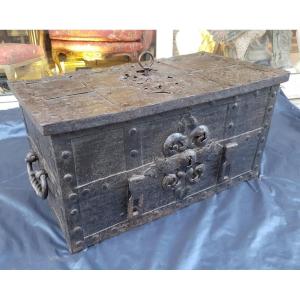"Nuremberg Chest Called "corsair" XVIIth"
Chest called "Corsair chest" from Nuremberg in clad and riveted iron from the 17th century opening from above. The lid has in the center an ornamentation of moving foliage forming an escutcheon whose center is formed of a small pivoting plate hiding a keyhole. When you rotate this small plate, you discover the lock entry into which you can insert your original key which allows the opening of the trunk by activating an ingenious and robust mechanism with ten anchoring points with their ten original bolts, 5 of which work. Inside the lid, the lock mechanism is hidden under a large perforated plate and at the bottom of the trunk, on one side, there is a small cassette opening with a bolt and its original key. The front side is decorated with a false keyhole in the shape of a fleur-de-lis. Large handles, twisted in the middle, located on each side allow the chest to be transported. These chests were intended to keep important documents, precious objects or even money during land and sea journeys. One of the characteristics of the Nuremberg chests was their complex mechanism making them practically inviolable for that time. Made in Germany in the Nuremberg region



